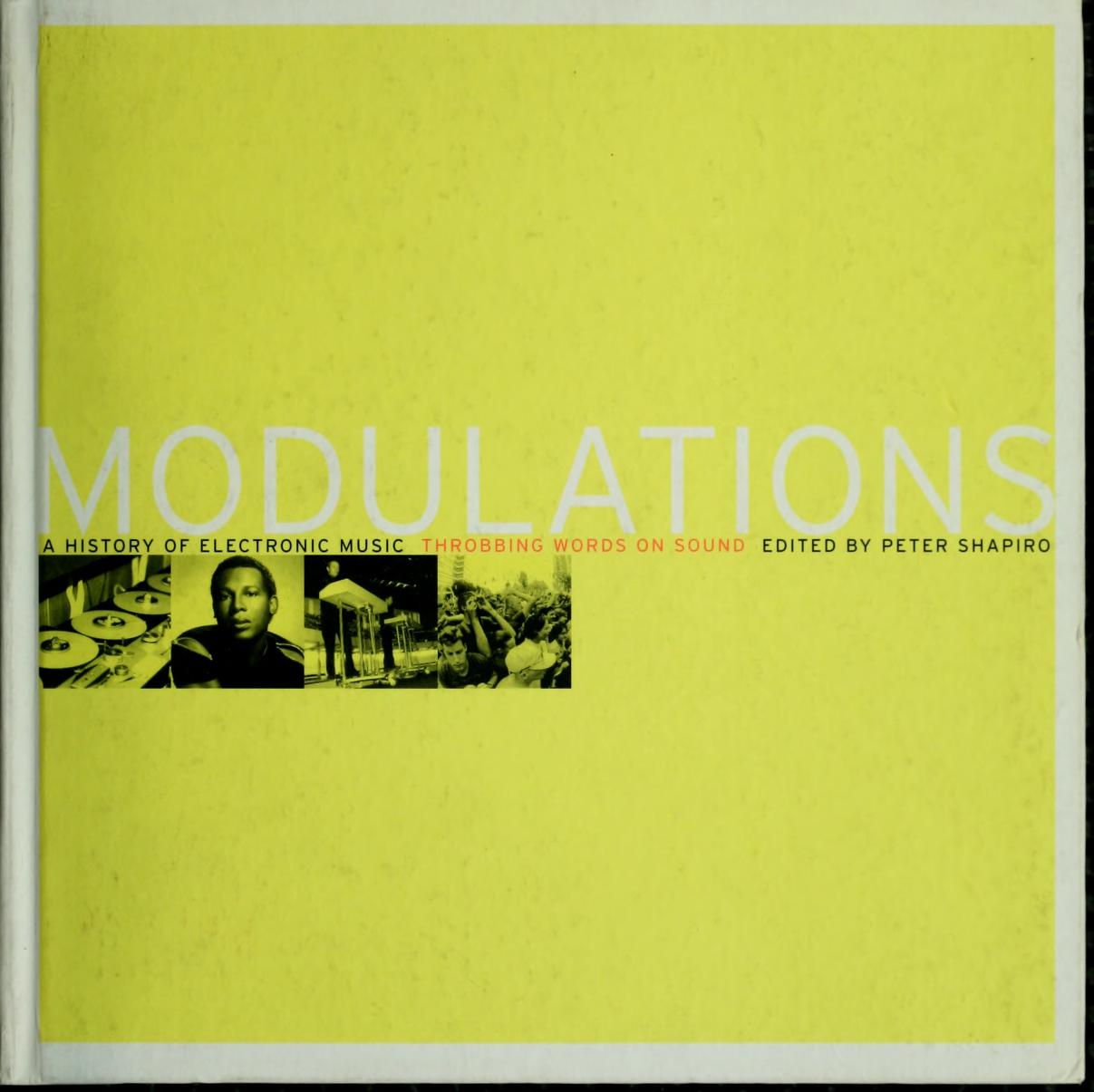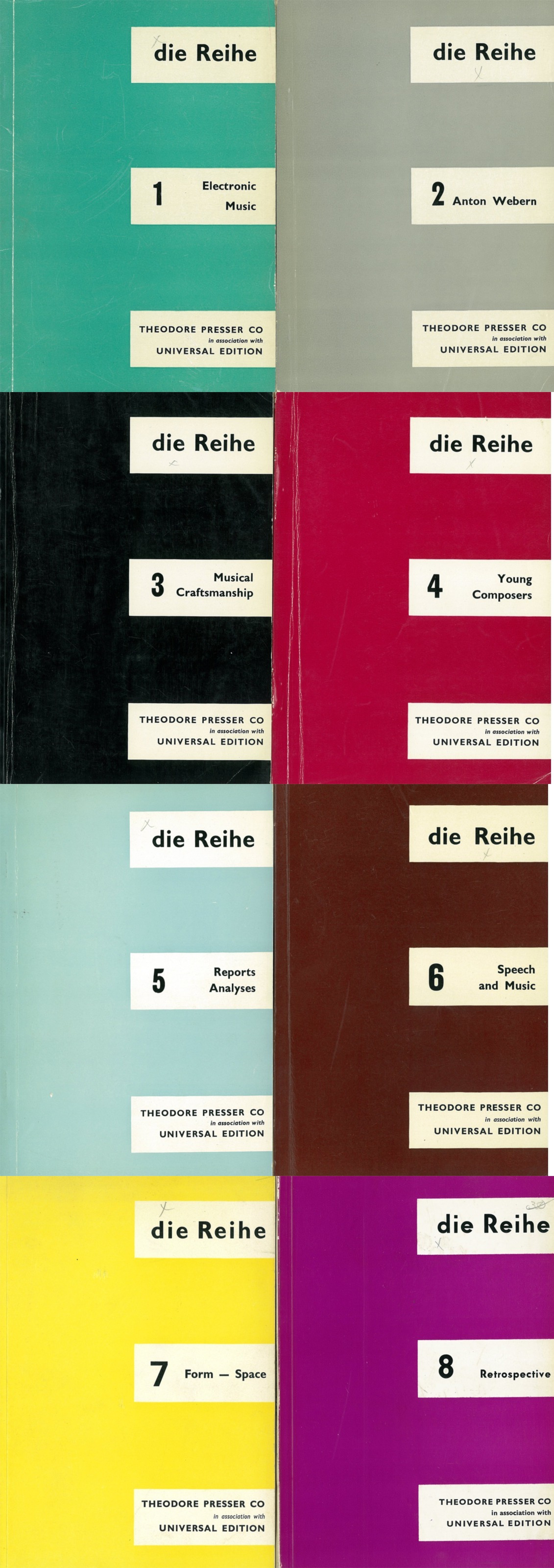Peter Shapiro (ed.): Modulations: A History of Electronic Music: Throbbing Words on Sound (2000)
Filed under book | Tags: · electronic music, hip hop, krautrock, music, music history, sound synthesis, technology

Modulations contains several large essays written by music critics and musicians that provide historical and critical survey of electronic music by genre, discussing labels, sub-genres, stylistic developments, musicians, and records.
Chapters by Rob Young (Pioneers), Simon Reynolds (Krautrock), Peter Shapiro (Disco, Post Punk), Kodwo Eshun (House), David Toop (Hip-Hop), Mike Rubin (Techno), Chris Sharp (Jungle), Tony Marcus (Ambient), Kurt Reighley (Downtempo), and Michael Berk (Technology).
Project director: Iara Lee
Publisher Caipirinha Productions, New York, 2000
ISBN 189102406X, 9781891024061
255 pages
Film reviews: Stephen Holden (NYT, 1998), Tony Ramos (Hyperreal, n.d.).
PDF (39 MB, no OCR)
See also film documentary, dir. Iara Lee, 1998, 75 min.
Die Reihe: A Periodical Devoted to Developments in Contemporary Music, 1-8 (1957-1968)
Filed under magazine | Tags: · electroacoustic music, electronic music, music, music criticism, music theory, serialism

Die Reihe was a German-language music journal, edited by Herbert Eimert and Karlheinz Stockhausen between 1955 and 1962. An English edition was published, under the original German title, between 1957 and 1968.
“The journal, whose title means “The Row” or “The Series”, owes its genesis to the founding of the electronic music studio of the Nordwestdeutscher Rundfunk (NWDR) in Cologne (later WDR) under the influence of Werner Meyer-Eppler, and the realisation that technology was becoming an important element in the work of younger composers. The contributions from composers working in the studio were frequently based on their projects there, and in the early stages of competing with the radio-play department for resources, Eimert found having such a journal useful. It helped to raise the studio’s educational and academic profile above the entertainment aims of other departments of the radio station, as well as providing opportunities to young authors for publication.”
Contributors include György Ligeti, Mauricio Kagel, John Cage, Pierre Boulez, and others.
Reviews: Dika Newlin (of 1st DE issue, Notes, 1956), Dika Newlin (of 1st EN issue, Notes, 1958), Dika Newlin (of 2nd EN issue, Notes, 1959), Dika Newlin (of 3rd EN issue, Notes, 1960), George Perle (of 3rd EN issue, J Music Theory, 1960), Dika Newlin (of 5th EN issue, Notes, 1962), P.A.E. (of 5th EN issue, Music & Letters, 1962).
Commentary: John Backus, “Die Reihe—A Scientific Evaluation” (Perspectives of New Music, 1962).
Tables of contents of German edition
Wikipedia
Edited by Herbert Eimert and Karlheinz Stockhausen
Publisher Theodore Presser, Bryn Mawr, PA, with Universal Edition, London, 1957-1968.
800 pages
Each of the eight issues was dedicated to a different theme, announced in a subtitle (with links to sections in PDF):
Electronic Music, 1957, vi+62 pp
Anton Webern, 1958, vii+100 pp
Musical Craftsmanship, 1959, 88 pp
Young Composers, 1960, 135 pp
Reports—Analyses, 1961, 121 pp
Speech and Music, 1964, 95 pp
Form—Space, 1964, 87 pp
Retrospective, 1968, 98 pp
All 8 issues in single PDF (17 MB, no OCR)
Comment (1)Lucie Vágnerová: Sirens/Cyborgs: Sound Technologies and the Musical Body (2016)
Filed under thesis | Tags: · body, cyborg, electronic music, feminism, gender, music, sound art, technology, women
“This dissertation investigates the political stakes of women’s work with sound technologies engaging the body since the 1970s by drawing on frameworks and methodologies from music history, sound studies, feminist theory, performance studies, critical theory, and the history of technology. Although the body has been one of the principal subjects of new musicology since the early 1990s, its role in electronic music is still frequently shortchanged. I argue that the way we hear electro-bodily music has been shaped by extra-musical, often male-controlled contexts. I offer a critique of the gendered and racialized foundations of terminology such as “extended,” “non-human,” and “dis/embodied,” which follows these repertories. In the work of American composers Joan La Barbara, Laurie Anderson, Wendy Carlos, Laetitia Sonami, and Pamela Z, I trace performative interventions in technoscientific paradigms of the late twentieth century.
The voice is perceived as the locus of the musical body and has long been feminized in musical discourse. The first three chapters explore how this discourse is challenged by compositions featuring the processed, broadcast, and synthesized voices of women. I focus on how these works stretch the limits of traditional vocal epistemology and, in turn, engage the bodies of listeners. In the final chapter on musical performance with gesture control, I question the characterization of hand/arm gesture as a “natural” musical interface and return to the voice, now sampled and mapped onto movement. Drawing on Cyborg feminist frameworks which privilege hybridity and multiplicity, I show that the above composers audit the dominant technoscientific imaginary by constructing musical bodies that are never essentially manifested nor completely erased.”
PhD Dissertation
Publisher Graduate School of Arts and Sciences, Columbia University, 2016
Advisor: Ellie M. Hisama
242 pages

